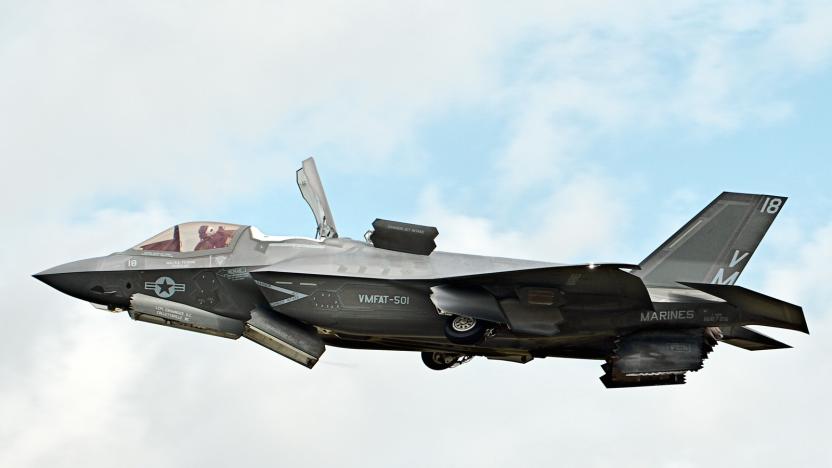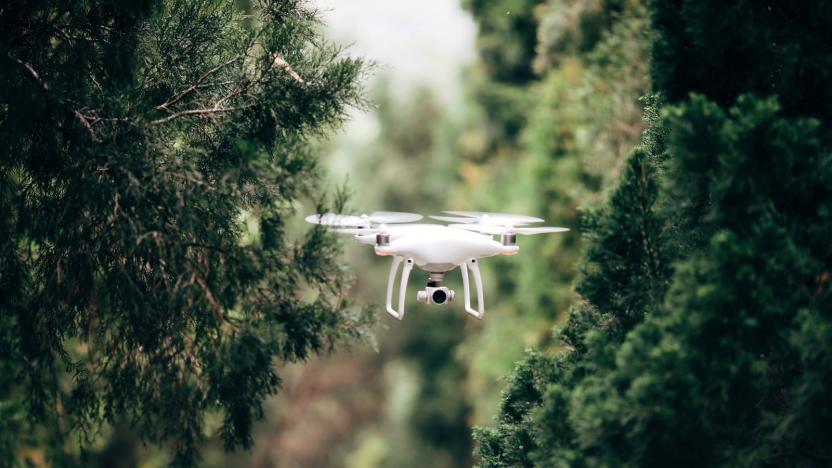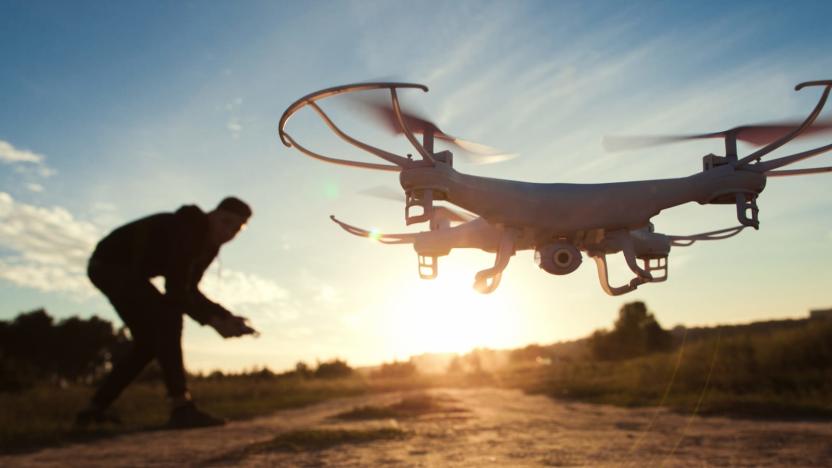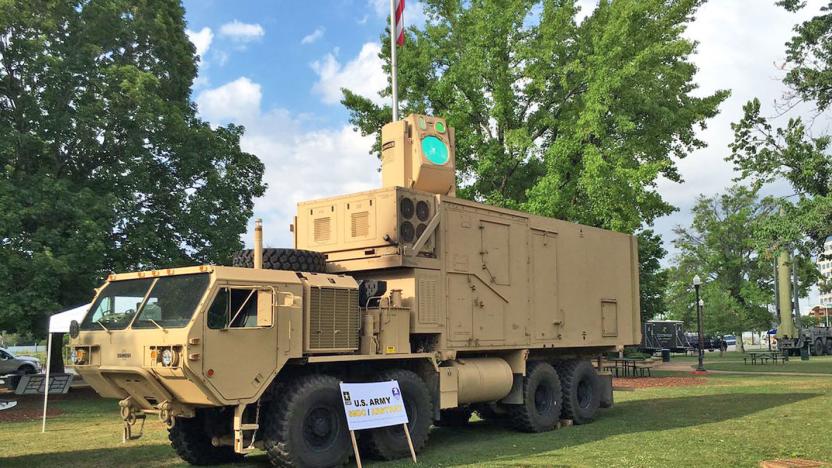military
Latest

Boeing shows its vision for a hypersonic spy aircraft
Lockheed isn't the only one hoping to make a hypersonic spy aircraft. Boeing has provided early details on its own design for a hypersonic tech demonstrator that would lead to a spiritual successor to the SR-71 Blackbird. In some ways, it's a logical extension of the company's X-51A Waverider: the wedge-shaped, twin-tail body is designed to minimize drag while gulping in as much air as possible. It would be about as long as the Blackbird, but its Mach 5-plus top speed would leave the older Mach 3.2 jet far behind.

Army base pulls Chinese security cameras over 'negative perception'
If it wasn't already clear that concerns over the security of Chinese equipment are reaching a fever pitch, it is now. The US Army has pulled five of Hikvision's surveillance cameras from Fort Leonard Wood in Missouri not because they pose an active security risk (they were on a closed network and monitored the roads), but because it's worried about the "negative perception" following media reports. Hikvision is 42 percent owned by the Chinese government, which has previously raised concerns that they might be used to spy on American operations.

F-35 may see combat in 2018
After a very long and problematic development process, the F-35 Lightning II is about to serve on the front lines. The US Marine Corps is deploying the F-35B (the short takeoff and vertical landing variant) to ships in the Central and Pacific Command theaters in the spring and summer of 2018. The 13th Marine Expeditionary Unit is traveling aboard the USS Essex, which is headed to the Middle East, while the 31st will be attached to the USS Wasp and might head to the coast of North Korea.

This year we took small, important steps toward the Singularity
We won't have to wait until 2019 for our Blade Runner future, mostly because artificially intelligent robots already walk, roll and occasionally backflip among us. They're on our streets and in our stores. Some have wagged their way into our hearts while others have taken a more literal route. Both in civilian life and the military battlespace, AI is adopting physical form to multiply the capabilities of the humans it serves. As robots gain ubiquity, friction between these bolt buckets and we meat sacks is sure to cause issues. So how do we ensure that the increasingly intelligent machines we design share our ethical values while minimizing human-robot conflict? Sit down, Mr. Asimov.

Pentagon funded UFO identification program for 5 years
Recent UFO research isn't just the work of the X-Files or former pop punk stars. The New York Times has learned that the US Department of Defense quietly funded a program (Advanced Aerospace Threat Identification) designed to explain UFO reports. The program was initially funded in 2007 at the behest of Senator Harry Reid, and sent most of its money ($22 million per year) went to an aerospace firm run by his friend Robert Bigelow, who's "absolutely convinced" UFOs have visited Earth and has been making inflatable habitats for NASA. The money stopped flowing in 2012, but the program is technically active to this day.

Pentagon left public intelligence gathering data on exposed server
Even intelligence gatherers aren't immune to making mistakes that leave data wide open. Researchers at UpGuard have revealed that the US military's Central Command and Pacific Command left "at least" 1.8 billion collected internet posts exposed on a misconfigured Amazon Web Services S3 server. Some of the data goes as far back as 2009. There doesn't appear to be any private content in the mix, and it's not clear that malicious intruders accessed it before the Department of Defense locked things down on October 1st (after notification from UpGuard). However, the exposure still raises concerns about both the government's approach to security and the kind of information it's collecting.

North Korean hackers allegedly stole South Korean and US war plans
According to a report, North Korean hackers acquired military intel last year from South Korea that included a plan to 'decapitate' North Korean leadership. According to a South Korean lawmaker, the 235 GB of data were stolen from SK and contained detailed plans in collaboration with the US as well as contingencies and infrastructure information.

Chevy is building a hydrogen fuel-cell transport vehicle for the Army
Chevy's venture into working with the Army on alternative-fuel vehicles isn't stopping with the Colorado ZH2. No, the pair are pushing forward with the Silent Utility Rover Universal Superstructure (SURUS) that takes the ZH2's hydrogen fuel cell power plant and mates it with what Defense One describes as a "flatbed truck trailer or even a railroad flatcar." The idea behind SURUS -- named for Hannibal's war elephants -- is to be an adaptable form of transport that can do anything from carrying injured troops to moving large amounts of cargo like diesel-powered generators in the theater of war.

Russia is hacking the phones of NATO soldiers
Russia's digital warfare campaign isn't limited to targeting distant servers. The Wall Street Journal has learned that Russian hackers are targeting individual NATO soldiers near, such as those deployed to Poland and the Baltic states. The intruders are compromising phones or Facebook accounts, in some cases grabbing data from handsets and erasing contacts. And while the Russian government has historically denied involvement in any hacking campaign, officials have little doubt that it's behind the attacks.

British warships will soon have Siri-like voice controls
British warships will soon integrate Siri-like voice systems into their controls, according to the head of the UK's Royal Navy. Speaking at the Defence and Security Equipment International exhibition -- one the biggest arms fairs in the world -- First Sea Lord Admiral Sir Phillip Jones said the Royal Navy wanted to embrace the speed at which warfare is being transformed by IT, and pointed to new Type-31 frigates as an example.

Security lapse exposed thousands of military contractor files
Thousands of files containing the private info of US military and intelligence personnel have been exposed online. The documents (which included a mixture of resumes and job applications) were found on a public Amazon Web Services server by cybersecurity firm UpGuard. A research analyst for the company traced the files back to a North Carolina-based private security firm known as TigerSwan. In a statement on Saturday, TigerSwan blamed the lapse on TalentPen, a third-party recruiting vendor.

DJI drones are getting an offline mode for secret flights
Chinese manufacturer DJI is adding a local data mode to its drones. Once enabled, the new feature will stop the company's apps from collecting user data (such as photos, videos, and flight logs). Although, DJI claims the update is in response to public demand, it's hard to ignore the security concerns recently raised by the US army. Less than two weeks ago, the military ordered staff to halt use of all DJI hardware and applications, citing "operational risks."

The military can shoot down drones that fly over bases
Drones can cost a pretty penny, so make sure not to fly them too near an airport... or a military base. The Pentagon has approved a new policy that gives military bases the right to shoot down or seize both private and commercial UAVs that encroach upon their airspace and are deemed a threat. While details about the policy remain classified, Pentagon spokesperson Navy Capt. Jeff Davis says the new guidance gives bases "the ability to take action to stop these threats (i.e. UAVs or drones) and that includes disabling, destroying and tracking [them]."

Watch the US Navy’s electromagnetic catapult launch a fighter jet
The US Navy's next-gen Electromagnetic Aircraft Launch System (EMALS) has already shown it can hurl weighty dead-loads. Now, after months of trials, it just propelled its first actual aircraft. A jet fighter performed the first EMALS launch and recovery from the USS Gerald R. Ford on Friday.

The Navy’s railguns are ready for live-fire field tests
The US Navy has been testing its railguns, which fire shells at high velocity using electromagnets instead of explosive propellant, for years. Test footage emerged in 2012 showing off successful demonstration of the experimental weapon on land targets. But at long last, the military's new artillery piece is ready for live-fire testing in the field.

US Army wants helicopters to refuel at robotic pumps
Militaries regularly set up fueling stations at forward bases so that helicopters can get back to the fight as quickly as possible. However, requiring fuel crews creates huge risks and logistical headaches: you're sending people to a dangerous, isolated section of the battlefield for a fairly mundane role. Thankfully, the US Army might not need to take that risk for much longer. It's testing an unmanned station, the Autonomous & Robotic Remote Refueling Point (AR3P for short), that can top up a helicopter with no human involvement. Much like Tesla's robotic charger, it would use self-aligning, articulated arms to hook a fuel line to a helicopter all by itself. That, in turn, would let helicopters fly at all hours without putting footsoldiers in harm's way, and would likely refuel them faster.

US Army expects to take down planes with anti-air lasers
Forget shooting down drones with vehicle-mounted lasers -- the US Army is ready to take on the bigger machines. Space and Missile Defense Command chief Lt. Gen James Dickenson has revealed that the Army is preparing lasers that are ten times more powerful than the ones in testing now, at between 50kW to 100kW. That kind of wattage is strong enough to take down aircraft, and might even throw missiles off their targets by confusing their sensors. They won't necessarily require gigantic trucks like they do today, either.

US Cyber Command may be splitting off from the NSA
It sounds as though the United States' Cyber Command will break off from the National Security Agency and be more aligned with the military in the future. The move would "eventually" cleave Cyber Command from the intelligence-focused NSA and instead align it more with the military, according to the Associated Press. "The goal is to give Cyber Command more autonomy, freeing it from any constraints that stem from working alongside the NSA," AP reports. The NSA's core task of intelligence gathering sometimes is at odds with military cyber warfare operations, hence the proposed separation. Prior to this, the two had clashed on getting intel from Islamic State networks (the NSA's task) and attacking (Cyber Command's).

US Army is building a versatile, flying squirrel-like drone
The military is constantly working on new drone technology. That includes new types of drones like autonomous boats and small swarming UAVs as well as ways to combat drones, like frying them with microwaves, guided bullets and hacking. Right now, the US Army is working on a small, lightweight drone that can take on a number of tasks depending on what's needed in a given situation.

Russian exoskeleton suit turns soldiers into Stormtroopers
In a bid to make its armed forces look even more intimidating, Russia has taken inspiration from science-fiction to create some futuristic-looking new combat suits. Developed by the state-owned Central Research Institute for Precision Machine Building, this very Star Wars-esque combat armor features a powered exoskeleton, ballistic protection from bullets and shrapnel and a heads-up display. While just a concept at the moment, the suit's designers hope it will enter full production in the next few years.








